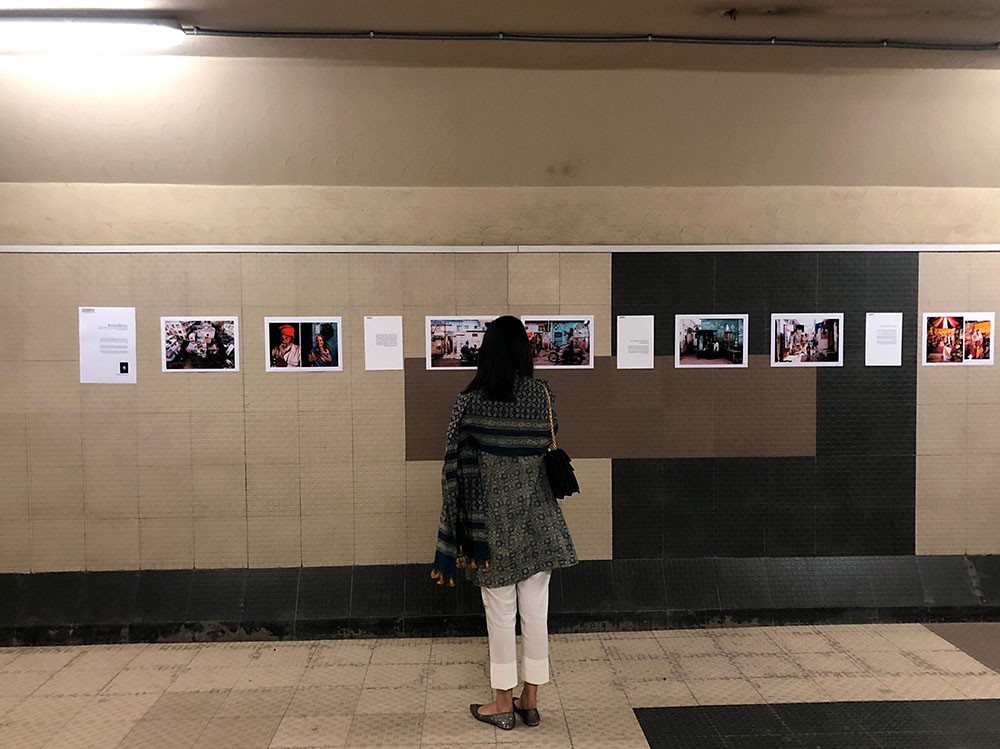
An underground Metro bus station proved to be a unique venue for the Pakistan Photo Festival Fellowship exhibition in terms of making art ‘accessible’ to common man

On a crisp February afternoon, I parked my car near Kalma Chowk on Ferozpur Road and walked down to the underground Metro Station nearby. The rays of the sun had turned to a rich ochre, and commuters, tired from another long day at work, were hustling and bustling about, preparing to make their journey home.
Much to my surprise, the underground station -- a long, wide tunnel -- had been used as a backdrop for the Pakistan Photo Festival Fellowship (PPFF) exhibition I was hoping to attend. Decidedly first of its kind, the exhibition featured works by young individuals who had been selected from a pool of hundreds from across Pakistan and awarded the seven-month long fellowship that was based in Lahore. The idea, according to Shah Zaman Baloch, the main organiser and funder of the fellowship, was to produce thought-provoking "documentary photography" works on pressing social, economic, and legal issues the country is faced with, and open them for public viewing.
"In Europe and the West, art is presented to the public, and their reaction is valued. In Pakistan, the art scene is dominated and, to some extent, controlled by the various art galleries that are accessible only to the middle- and upper-middle classes," Baloch said, talking exclusively to TNS.
"The masses in our country, such as those that travel by the Metro [bus] would never have the opportunity to experience art. This photo exhibition is meant for them. With a footfall of over 20,000 individuals per day at this one station alone, the venue fulfills its purpose of exposing the average Pakistani to photo journalism and art."
Coming down into the tunnel, the photos immediately caught my eye, standing out from the otherwise orderly and sterile setup of the station. Vibrant, colourful portraits were to be found in Faizan Ahmad’s series, titled ‘From The Metro Bus: Uncommon Stories of the Common People.’ The story of a single mother of four who worked at the station so that she could feed as well as educate her children, stood out, her face covered by a medical breathing mask but the pain unmistakeable in her eyes.
Travellers rushing to and fro were at once halted in their footsteps, some peering thoughtfully at the images whereas others stood open-mouthed, confused but pleased at the unexpected art show in their daily commute.
Another series covered the neighbourhood of Naryanpura, Pakistan’s biggest minorities’ compound where the Hindus, Sikhs and Christians live together in harmony. Photos depicting narrow alleys, brightly coloured laundry fluttering in the wind, small children playing barefoot, bright and joyful images of a local wedding, all conveyed the sense of camaraderie and religious tolerance so rarely found in our nation.
One of the recipients of the Fellowship, Ema Anis gave valuable insight into the premise of the programme: "It was not based on regular, pretty pictures but about introducing a new form of photojournalism and documentary photography.
"When people think about photography in Pakistan, landscapes and images of landmarks come to mind, but there’s no story or meaning to it, no projects that are well researched," she said.
Muhammad Arshad, a local bank employee who was standing there and admiring the photographs, noted: "When the Metro bus system was set up in Lahore, people were pushing and shoving, and there was no order. But with time, everyone learned the way for things to be done and how to be respectful when commuting on the bus. Similarly, art broadens our horizons. Making it accessible to the people at large shall discourage extremist mindsets."
The impetus for organising such a programme was to develop photojournalism skills amongst young local talent. As Baloch elaborated, "Submissions for the fellowship were called from across Pakistan. Eventually, 15 people were selected and trained under five mentors from around the world. They included Mathieu Paley, a French photographer who has worked with the National Geographic, noted Indian photographer Mahesh Shantaram, and Asim Rafiqui from Sweden who has been featured in The Wall Street Journal and Newsweek.
"The fellows spent eight months developing their projects, on topics as diverse as the discrimination faced by minorities, the state of affairs in Pakistani nursing homes, the experience of emigration to the UK, and student politics at college campuses."
Khawar Abbas, a student and regular commuter of Metro bus remarked with a twinkle in his eye, "I love looking at these pictures. I love to learn about people and their stories. I only wish the accompanying text was in Urdu so that I could understand."
A fair point, as the average Pakistani is not able to read or write in English. But despite the language barrier, curiosity struck many a passersby on that dusky evening.